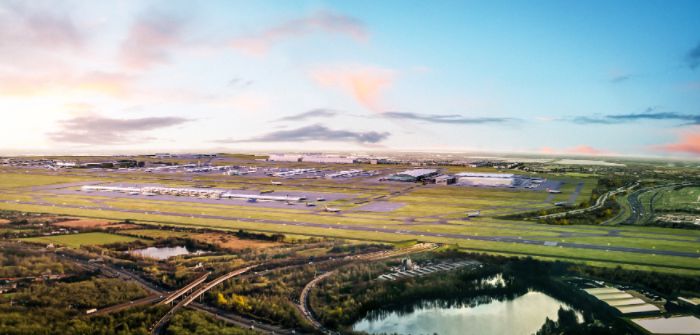London-based members of global architectural practice Grimshaw are among the members of the Heathrow Integrated Design Team. Grimshaw partner Jolyon Brewis explains how the team has been delivering outcomes far greater than the sum of its parts
We’re nearing the end of the public consultation on Heathrow’s masterplan for expansion and have seen great community engagement and feedback that is helping to shape the design further. The environmental impacts of aviation generally, and Heathrow’s expansion specifically, have been strong themes of the feedback we have received so far. It is good to see how much emphasis Heathrow and the public are placing on issues of environment and sustainability.
Everybody working on the vision for an expanded Heathrow is very aware of the environmental, societal and moral imperative to build as sustainably as possible. While some argue that the project should not go ahead, Heathrow’s sustainability and environment director, Matt Gorman, puts it well when he says, “It’s naïve to pretend that, in an interconnected international network, not building a third runway at Heathrow will stop journeys happening and cut emissions – passengers will simply route via other hubs.”
Gorman continues to position Heathrow as an anchor for change, where we can use the airport’s scale and influence to transform the way the global aviation sector tackles environmental challenges. At Grimshaw we are passionate about helping our clients to develop new buildings and infrastructure as sustainably as possible; this goal has particular resonance in the development of airports.
Grimshaw has worked with Heathrow for the past three years to help design a holistic scheme that will enable it to meet its targets of growing affordably and sustainably. It is this imperative that we take into our design meetings, and I sit within the Leadership group of Heathrow’s Integrated Design Team (IDT), a group of seven companies (Atkins, Mott MacDonald, Arup, Jacobs, Grimshaw, Quod and Wood) comprising engineers, architects and planning experts. Together we are researching, consulting, designing and planning for an expanded Heathrow.
The IDT works in such a way that a task order is issued from our client and the various companies compete for the job; this ensures that the most qualified members are responsible for delivering on their expertise. This healthy and professional competition has driven fantastic collaboration between members of the group, and the inclusion of SMEs within task order teams. As a result, the team has access to incredible expertise and great diversity of thinking and approach. It is rare to work on a program where such productive ‘creative tension’ is apparent on a daily basis, and I believe it has allowed the IDT to deliver outcomes far greater than the sum of its parts.
We are proud of the strides we have made in terms of a robust and aspirational sustainable design strategy for Heathrow, responding directly to Heathrow’s Strategic Brief and its plan for sustainable growth, Heathrow 2.0.
Early in our process, the Integrated Design Team highlighted a number of sustainability challenges, including: achieving zero carbon; limiting the construction impact; ensuring Heathrow is resilient to the potential impact of extreme climate events; driving operational resource efficiency; and designing for the safety and well-being for colleagues, passengers and other users.
Such targets have far-reaching and complex ramifications. Working as part of the IDT, we are addressing these design challenges with strategies that consider established sustainability frameworks such as the UN’s Sustainable Development Goals and the UK Green Building Council’s framework to achieve net zero carbon buildings in both construction and operation. Although the scheme for the expanded Heathrow Airport is still at a formative stage, wherever possible we are finding tangible projects that illustrate how we can meet our sustainability challenges.
Across the masterplan we are deploying innovative approaches that reduce the amount of infrastructure, and therefore the embodied carbon, required; examples include the M25 and Covered River Corridor crossings, where we are reducing the length of tunnels by delivering bridge-type solutions.
Across the whole scheme we are developing system-based approaches to maximize offsite manufacture, minimize embodied carbon and utilize the expansion innovation hubs located around the UK. In this way, the new built infrastructure will embrace principles of the circular economy, including design for disassembly and reuse of components.
New passenger terminal facilities and transport interchanges are being designed to optimize material and energy efficiency to an unprecedented standard. These buildings are conceived to be modular, lightweight and adaptable, with high levels of natural daylight, seasonal temperature variation and internal landscaping, to create a welcoming space for all those who travel through the terminal and onto their next destination.
Parking structures integrate photovoltaic panels as part of Heathrow’s strategy to maximize renewable energy generation on-site. The car park structures are being designed to safeguard for future trends by facilitating a significant uptake in electric vehicles, while being designed to be adaptable to emerging autonomous parking systems and operation.
Our landscape strategy is crucial to achieving the sustainable outcome we seek for Heathrow and its neighbors. It includes concepts for using landscape in a multifunctional way to help improve amenity, active travel and carbon sequestration, and to increase biodiversity through habitat creation and restoration.
Overall, the amount of land required for expansion has been minimized as far as is practical. These are realistic solutions for a sustainable expansion and they could not have been developed in isolation. By continuously working with other companies and being challenged to work better and smarter on this project, I feel like we are all involved in something extraordinary. There is still a long way to go and we are very much on target to set a new benchmark for sustainable infrastructure development on a grand scale.

